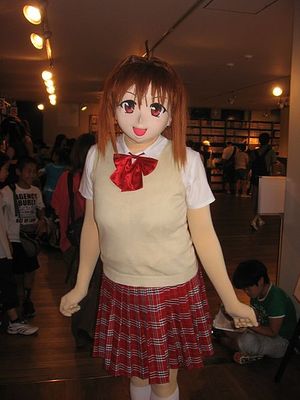Animegao: Difference between revisions
(Created page with "{{Header|Animegao 03/21}} thumb|150|{{bc|A "doller" at the 2008 Kyoto International Manga Summit}} The Japanese n...") |
m (Text replacement - "Canada" to "Canada") |
||
| (3 intermediate revisions by the same user not shown) | |||
| Line 1: | Line 1: | ||
{{Header|Animegao 03/21}} | {{Header|Animegao 03/21}} | ||
[[File:Animegao at Kyoto International Manga Summit.jpg|thumb|150|{{bc|A "doller" at the 2008 Kyoto International Manga Summit}}]] | [[File:Animegao at Kyoto International Manga Summit.jpg|thumb|150|{{bc|A "[[doller]]" at the 2008 Kyoto International Manga Summit}}]] | ||
==Animegao== | ==Animegao== | ||
{{Main|Kigurumi}} | |||
Animegao (アニメ顔, anime face) is a type of [[kigurumi]] used to portray anime or cartoon characters. The face of the performer is fully covered with a stylized mask, and clothing similar to the character's typical attire is used. Animegao costumes are used both in professional stage shows and by cosplayers, sometimes called "[[doller]]s", who make custom masks of various characters. It is still a very minor part of the cosplay scene in Japan, though around 2005, it began attracting attention in other countries, including the United States, [[Canada]], and European countries. | |||
The [[Japan]]ese name for costumed performers is kigurumi (着ぐるみ). The name comes from the Japanese verb kiru (着る, to wear) and noun nuigurumi (ぬいぐるみ, stuffed toy). Japan's kawaii aesthetic means that mascots are commonly used for promotional purposes. These mascots are often constructed with an appearance that is more chibi than Western mascots, with a massive head that encompasses the performer's entire upper body and the arms low on the body. Other mascots more greatly resemble anime characters. | |||
{{sa-cosplay}} | |||
{{footer}} | {{footer}} | ||
[[Category:Cosplay]][[Category:Japanese culture]] | [[Category:Cosplay]][[Category:Japanese culture]] | ||
Latest revision as of 15:47, 13 August 2021

Animegao
 Main article: Kigurumi
Main article: Kigurumi
Animegao (アニメ顔, anime face) is a type of kigurumi used to portray anime or cartoon characters. The face of the performer is fully covered with a stylized mask, and clothing similar to the character's typical attire is used. Animegao costumes are used both in professional stage shows and by cosplayers, sometimes called "dollers", who make custom masks of various characters. It is still a very minor part of the cosplay scene in Japan, though around 2005, it began attracting attention in other countries, including the United States, Canada, and European countries.
The Japanese name for costumed performers is kigurumi (着ぐるみ). The name comes from the Japanese verb kiru (着る, to wear) and noun nuigurumi (ぬいぐるみ, stuffed toy). Japan's kawaii aesthetic means that mascots are commonly used for promotional purposes. These mascots are often constructed with an appearance that is more chibi than Western mascots, with a massive head that encompasses the performer's entire upper body and the arms low on the body. Other mascots more greatly resemble anime characters.
| Cosplay / Japanese Street Fashion subcultures |
|---|
|
Chat rooms • What links here • Copyright info • Contact information • Category:Root